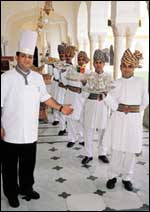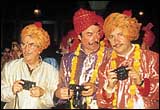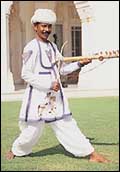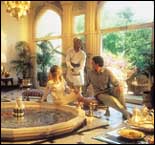


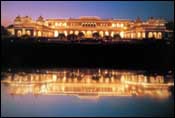
Rambagh Palace Built By A King, Fit For God! |
|
IF I could make one wish of mine come true, I would want to be married all over again with the grandeur of a traditional royal wedding at the Rambagh Palace in Jaipur. Fancy taking wing? Not really, there are people who do it for the sheer experience of the traditional Rajasthani custom. Like James Lindsay of London's aristocracy married Arabell Tait in a Jaipuri wedding ceremony at the Rambagh on Valentine's Day in 1995, he wearing a bright turban and she a colourful odhini. And the couple celebrated their honeymoon at the Rambagh Palace, which is a Taj Group property, and one that is a feast for body and soul.
I can tell you about the palace hotel, I stayed there, and it is a hotel quite unlike any other in my experience. The Taj people say the Rambagh was a palace built by a king, but fit for God. I believe them. The king was Maharaja Sawai Ram Singh II. And the Rambagh (it was named after him, naturally) was built as a modest four-room pavilion in 1835 for the queen's favourite hand-maiden, with picturesque gardens and neatly manicured lawns. The Maharaja's grandson, Prince Sawai Man Singh II, was brought here on his accession. A private school was set up for the young prince, his brother and a few chosen sons of Jaipur aristocracy. And in 1925, the Maharaja elevated Rambagh to the status of a palace. It was the Maharaja Sawai Man Singh II who decided to make Rambagh his royal residence. He swiftly set about changing the 47 sprawling acres of estate with amazing verve and prevision. The gardens were enlarged, three new wings were added in exactly the same pattern as the earlier ones, and that itself became an architectural masterpiece. Elegance personified, art mirrored by reality. And the Maharaja married the beautiful Princess Gayatri Devi of Cooch Behar and brought her to Rambagh as his bride in 1940. She writes in her memoirs, "The Maharaja had rooms specially decorated for me by his favourite interior designer, Hammonds of London. Pale cream fitted carpets, light pink walls, beautiful chandeliers, pale pink brocade curtains embellishing wide windows, my bedroom was the prettiest in the palace, furnished with a bed of soft silk satin with light brocade bed spreads, a colourful divan, two armchairs with silver legs and a mirrored dressing table trimmed with pleated silk satin."
I stayed in the luxurious Sheesh Mahal suite, the glass theme reflecting itself in thousands of intricately cut glass pieces that form interesting patterns around the dome-shaped ceiling and on the walls of the room. It also had a kingsize bed and exquisite Indian furniture. Out of curiosity, I peeped into the former personal chambers of the Maharani Gayatri Devi. They are now known as the Maharani Suite. Rich red colours, silks, brocades, these were my first impressions. A canopied ceiling over the sitting area lent a certain flair to the suite. The parlour was adorned with antiques from all over Rajasthan. Two dressing rooms with highly polished mahogany furniture provided ample space for vestments. The oval bathroom, done in white and yellow Jaisalmer marble, was fitted with lion heads that spouted water. It was endowed with recessed lighting. I found the bathroom just another paean to good taste, exemplifying the Rambagh tradition. But coming back to the sepia toned history of the palace, with the passage of time, and with the abolition of the institution of Rajpramukh in 1956, there came many changes in the lives of the Indian princes. And Maharaja Sawai Man Singh II, with his customary foresight, decided to convert Rambagh into a hotel. He reasoned that Jaipur badly needed a first class hotel whereas he no longer needed to live in such a vast palace, especially after the household troops and guards were absorbed in the Indian Army and there was a shortage of staff.
So trained managers were hired to run the property and when the need was felt for professional expertise of the highest calibre, the Taj Group was asked to step in. The Maharaja was the first Indian prince to convert his palace into a hotel. He was strongly criticised by other Indian princes for this. But before the deal with Taj was struck, the Maharaja passed away in 1970 while playing a polo match in England. The Taj took over the management of Rambagh in 1972, and the palace since then has blossomed into an incomparable experience, an experience so far reserved for royalty. I was given a welcome that inspired visions of the glorious past and recaptured the lifestyles that royalty enjoyed. I believe when you make a special request, the Rambagh rolls out the red carpet. The central pathway leading right upto the main steps is decorated with fresh flower patterns, a group of mounted guards armed with spears and bedecked with regalia stand at hand while caparisoned elephants and camels wait patiently near the ramps of the palace. You are greeted with shehnai music and a cooling sherbet, girls in traditional Rajasthani finery welcome you with a tikka and garlands, and the Rajmata Gayatri Devi, whose palace it is and who lives in the Lily Pool, an adjoining mini-palace, all but comes to say, "Welcome to my home!"
I will not attempt to describe any more rooms, for there are too many of them, and also suites, like the Maharaja suites, the Royal suites, the Potikhanas � luxury bed-sitting rooms, the Luxury rooms, Safari rooms, all of which encourage you want to revel in the romance of stately living. And most of which have exquisitely carved antique furniture, small gurgling fountains in the living rooms, private terraces that overlook the gardens, Rajput paintings, deep-cushioned sofas and hand-knotted carpets, teak-panelled walls and brass lanterns. But I can do the gardens, all of which are featured in Peter Coats's book, The Most Beautiful Gardens in the World. There are five, all equally enticing. The Front Lawns are abloom with Ashoka and Lantana trees, while small bushes of Mandarin Oranges, Fish Tail Palm, Cannas and Bamboo groves contribute to the ambience of the Oriental garden. The Naksha gardens are a labyrinth of geometrical patterns and seasonal flowers. The Mughal Gardens, for want of suitable description, are another horticultural wonder, and the Sunken Lawns complete the delicate balance between man's ingenuity and nature's abundance. This is how the Rambagh's green man would put it, and if I were to add something of my own, it would be about the resplendent peacocks preening on the lawns and the flocks of migratory birds that frequent the gardens. They transport the palace into something else. Finally, the food. Ah! the Rajasthani food. My colleague, Mark Manuel, has described both the disciplines of Rajasthani cooking in this gourmet section, so I will not touch upon Marwari and Rajput cuisines. Instead, I will give you the stately dining rooms at the Rambagh Palace, the venues of royal repasts in the past. Executive Chef Sandeep Kalia has been with the Rambagh Palace for six years, and what he does not know about Rajasthani food is probably not worth eating at all. He explained to me that the Indian hospitality philosophy "atithi devo bhava", which means in Sanskrit that a guest is like God, is best exemplified in the Rambagh's dining rooms. I do not know if you can describe them as restaurants, though they have names and proper menus and lunch and dinner hours. The pride of place is taken up by Suvarna Mahal, which literally means the palace of gold, a high-ceilinged and breath-taking room with Florentine-style paintings, large gilt-framed mirrors that give the hall depth, and majestic chandeliers that envelop the room in a golden glow. In the morning, the sun enters through the floor-to-ceiling windows, lighting up your orange juice and making you feel reluctant to disturb the pretty picture by taking a sip. My advice, drink coffee instead. Jaipur is not coffee country, but at Rambagh, they make one of the finest cups I've ever had. Better even than Mysore. At Suvarna Mahal, the menu is Indian (Rajasthani, naturally), Continental and Chinese. I don't know about the foreign cuisines, but Rajasthani food is the food of kings. The fact that the Rajmata Gayatri Devi has most of her meals sent from here, is good enough for me. Rambagh also has the Neel Mahal, what in most other hotels (palace and otherwise) would be called a coffee shop. It is open 24 hours (though Jaipur goes to bed by 9.30 p.m.), a soothing blue, iridescent blue, dazzling blue eating place in which almost every shade of blue is explored. The walls of Neel Mahal are adorned with specially designed blue pottery, and blue, green and white tiles, done in the traditional Shekawat style. In this soothing mix of design and colour, you can order and have light meals, snacks and refreshments. Outdoors in the Mughal Gardens, there is the Panghat, which the Rambagh describes as its amphitheatre. I found it to be like a traditional Rajasthani village. Cultural shows are held here taking you back in time, folk artistes in traditional finery regale diners with music and dance. While under a canopy of trees, genuine Rajasthani food is cooked on mud platforms. And they have the Polo Bar, which Malvinder Narang, the Taj's head honcho in Rajasthan, told me was the only room in the palace that had been left untouched and retained its originality to the core. You enter the Polo Bar and your attention is arrested by a fountain in the centre. Rajiv Khanna, the Rambagh's general manager, said it is one of the finest examples of the famous blue pottery style of architecture of the region. This fountain was commissioned personally by Maharaja Sawai Man Singh II. The bar is also testimony to the Maharaja's passion and proficiency at polo. Ancient sepia tone photographs, trophies and memorabilia. The magic spun by this ambience, blended with the bar's fine wine list, its spirits and liquers, cannot be explained. It must be experienced. I am told that the Polo Bar is rated as one of the finest in the world. Although I didn't check it out, I know that somewhere in this magnificent edifice recreational activities like tennis, badminton, squash and table tennis. There's also an indoor swimming pool, a fitness centre with sauna, masseur, steam bath and a jacuzzi. There's a circuitous jogging track, and if you are inclined to it, the Rambagh will also organise horse riding and golf for your pleasure. I wouldn't recommend it, however. My idea of exercise was to lie back in the shade with a cooling drink in my hand (late afternoons, a mug of that excellent coffee), and listen to the Rajasthani folk musician flitting in and out of the hallowed corridors of the palace, and beneath the trees of the garden, with his ancient violin. When he gave voice and invoked the Sun God with a song, his feet tapping out an accompaniment with musical jhungroos, it was like a gentle sandstorm riding the desert. Rambagh Palace, Bhawani Singh Road, Jaipur 302 005, Rajasthan. Tel: 0141-381 1919. Fax: 0141-381 098. E-mail: [email protected]
|

Home Page
About the mag
Subscribe
Advertise
Contact Us
